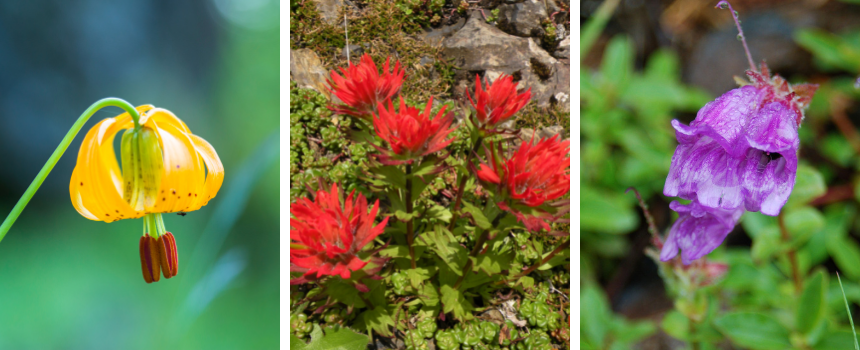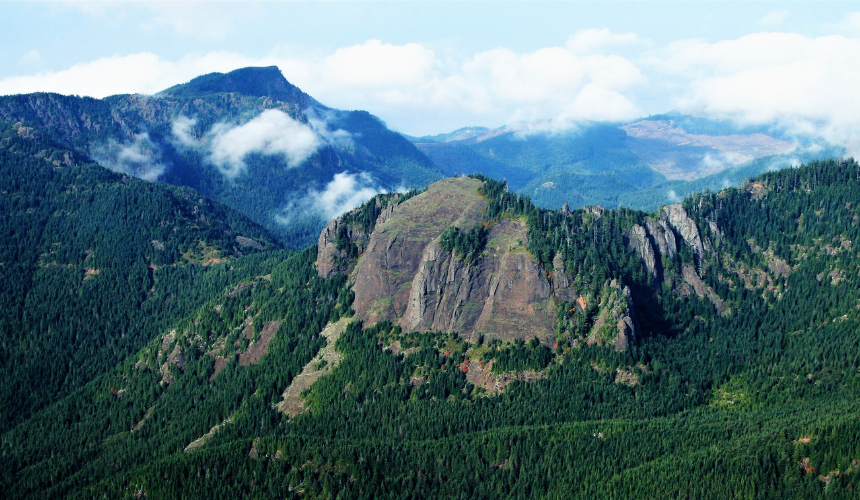
The Rainforest Reserve/Photo by Justin Bailie
Located adjacent to Oswald West State Park and above Cape Falcon Marine Reserve, the Rainforest Reserve is part of an uninterrupted 32-square-mile conservation corridor that stretches from the summits of 3,000-foot peaks within the Oregon Coast Range to Short Sand Beach and the sandy seabed and rocky reefs of the nearshore ocean. This type of protected land-to-sea corridor is unmatched in the state of Oregon.
On Oct. 26, 2021, on the heels of a five-year campaign spearheaded by North Coast Land Conservancy, the Rainforest Reserve was permanently conserved to be a place brimming with critical habitat for a wide array of wildlife and plant species, to help them adapt to a changing world, while also supporting the surrounding communities.
“Bringing this land into conservation allows us to unlock its future,” said Katie Voelke, Executive Director of NCLC. “It is a living, breathing, flowing and evolving place. Conservation allows it to live its most dynamic and abundant life. This is a living museum, a living laboratory, a globally rare and precious place, and it’s our community backdrop. Conserving this land gives us all a chance to be in the right relationship with the land and the people it sustains.”
“The Rainforest Reserve is a remarkable accomplishment that will significantly benefit our region in many ways,” added U.S. Rep. Suzanne Bonamici (D-Ore.). “I applaud Katie Voelke, the entire NCLC team, and the many supporters on the North Coast for this impressive achievement. As we address the climate crisis, strategic, community-driven conservation efforts like this project can help mitigate the most serious risks to plants, fish and wildlife while preserving the ecosystems we cherish for future generations.”
Onion and Angora peaks, the main fixtures of the Rainforest Reserve, were once rapidly chilled lava dikes and sills nestled 3,000 feet deep in the ocean. Over time, a submarine lava flow rose out of the ocean to become isolated nearshore islands. As a result, an unusual mixture of plants and animals evolved on those islands. They continued to evolve in isolation as the islands rose to be the high peaks forming the backdrop of the northern Oregon Coast skyline. Some of the species found on these coastal peaks exist nowhere else on Earth.
“We couldn’t be more thrilled about this acquisition by our good friends at North Coast Land Conservancy,” said Carla Cole, Integrated Resources Program Lead for the National Park Service. “The National Park Service recognizes that landscape-scale conservation is one of the most meaningful ways that we can protect diversity and ensure resilience in a rapidly changing world. Plants, animals and ecosystems need space and time to move and adapt. Conservation of mountain peaks, headwaters, forests, and salmon streams within the Rainforest Reserve will provide protection and refugia for many iconic species and habitats, and ensure that this special place will persist for the benefit and enjoyment of all Oregonians for generations to come.”

Columbia lily, Chamber’s paintbrush and Cardwell’s penstemon grow in the Rainforest Reserve.
The reserve includes the headwaters of five watersheds and provides drinking water to Cannon Beach and Arch Cape. As a result, conservation of the Rainforest Reserve will help ensure clean drinking water for residents and visitors and could help lower water treatment costs.
Clatsop County Commissioner Lianne Thompson stated: “Vision, tenacity and patience define the collaborative efforts to successfully create the Rainforest Reserve and protect this important section of the Coast Range. Thanks to all who put vision into action and secured the future of this north coast gem. It’s really a joy and a privilege to support a community effort like this. It’s good for the people, it’s good for the planet. What’s not to love?”
Protection of the Rainforest Reserve has been a goal of coastal conservationists for decades. Seventy years ago, Oregon’s first state parks superintendent, Sam Boardman, characterized the property as “one of the greatest opportunities for creating one of the outstanding natural parks in the nation.”
However, a sense of awe and respect for this place has existed in the peoples living here since time immemorial. This summit-to-sea corridor has provided abundant first foods, materials for tools and crafts, and more for the Clatsop and Tillamook people. NCLC’s acquisition of the Rainforest Reserve perpetuates a theft that first happened more than 150 years ago, when land treaties with the first nations were not honored. Thus, NCLC is committed to once again ensuring indigenous Clatsop and Tillamook community members have access to this land for a variety of cultural uses.
Campaign Background
In 2016, North Coast Land Conservancy entered into talks with EFM Inc., a forestland investment management company committed to sustainable forestry. That led Onion Peak Holdings, a subsidiary managed by EFM, to purchase 5,000 acres of forestland from Stimson Lumber Company. In keeping with EFM’s goals around enabling long-term land ownership, landscape protection and drinking water security, they signed a purchase and sales agreement with NCLC with a deadline of five years.
“NCLC’s compelling vision for this property inspires us to think bigger and be bolder in solving our climate crisis,” EFM CEO Bettina von Hagen said. “The creation of the Rainforest Reserve is an enormous contribution to the people of Oregon, who will have the opportunity to hike and enjoy this spectacular and unique landscape, and to the many plants and animals, including endemic species, that make the Rainforest Reserve home. We applaud NCLC for their vision, perseverance and tenacity in making this five-year vision a reality.”

Onion Peak and parts of the Angora Peak Complex are the main fixtures in the Rainforest Reserve ridgeline.
To secure the Rainforest Reserve and complete this landmark conservation project, NCLC raised roughly $11.8 million with the help of more than 1,000 donors and significant grants awarded by U.S. Fish and Wildlife; the Pacific Northwest Resilient Landscapes Initiative, a partnership among the Land Trust Alliance, Oregon Community Foundation, Seattle Foundation and the Idaho Community Foundation, with support from Doris Duke Charitable Foundation; Oregon Watershed Enhancement Board (OWEB); and M.J. Murdock Charitable Trust.
In addition, NCLC continues to provide technical support to the Arch Cape Domestic Water Supply District to acquire an additional 1,500 acres to create a community forest adjacent to the Rainforest Reserve.
“It’s been astounding to see what’s happened with fundraising for the project and the grants that came through,” NCLC Board President John Mersereau said. “Now that we have the property, there’s also the question of, what’s next? What is involved in the next phase? There is so much work to be done, but having met that initial goal with the acquisition is huge.”
An interim public recreation policy—including what uses will be permitted and where—is currently in place, while creation of a more robust and thoughtful public-access plan is underway. Through a grant from the National Park Service, a team of conservation and recreation planning specialists are facilitating that planning process with NCLC, neighboring landowners, community members at-large, and indigenous community members. Over the next year, they will be reaching out to the community to help create a cohesive, interconnected recreation and access plan that is user-friendly and provides opportunities to the public while also protecting ecologically sensitive areas.
“With its proximity to Oswald West State Park, the Rainforest Reserve plays a significant role in creating connectivity between protected areas on the coast,” Oregon Parks and Recreation Department Director Lisa Sumption said. “Since Sam Boardman first experienced this place, OPRD has supported a vision like the Rainforest Reserve. We look forward to collaborating with NCLC as we steward these places together, which contribute to the long-term health and well-being of people, plants and wildlife alike.
Nadia Gardner, volunteer chair of Friends of Cape Falcon Marine Reserve, added, “The Rainforest Reserve is unique in its connection to not only an incredible state park but also a marine protected area. The goals of Oregon’s five marine reserves are to conserve ocean biodiversity and contribute to scientific research. We are thrilled to see this area protected from the mountain peaks out into Oregon’s ocean.”

Comments